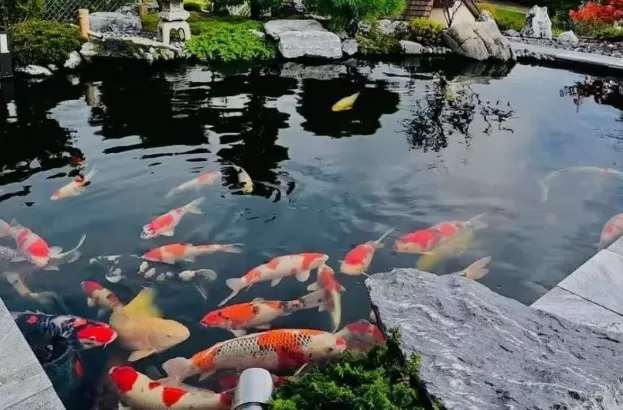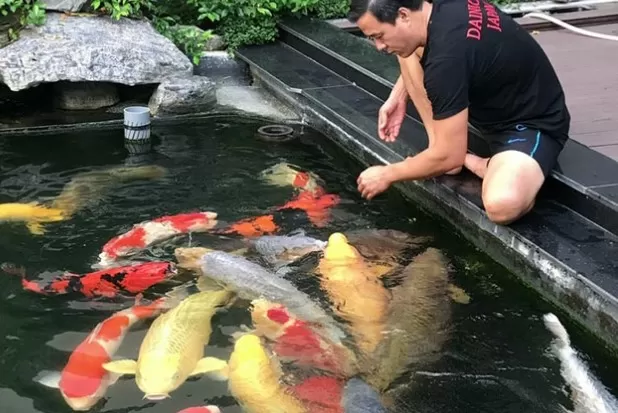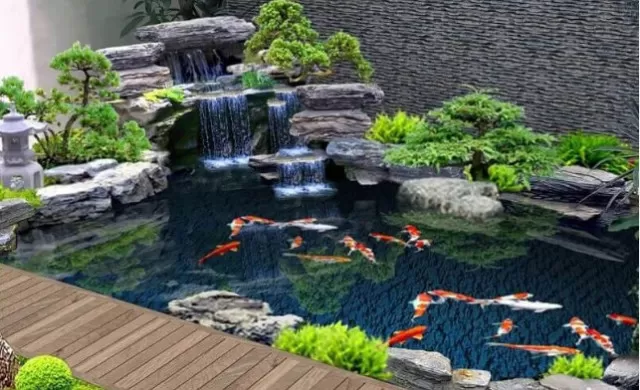Constructing Your Own Koi Pond. Koi fish are believed to bring good luck and prosperity.
Regardless of whether this is true, one thing is certain: these beautiful creatures will add a stunning splash of color and a peaceful ambiance to your yard. As koi are hardy fish, maintenance is a breeze. If you want to refresh your yard with a koi pond, learn how to build one.
Professional koi pond installation is expensive; it can cost anywhere from $10,000 to $20,000, with maintenance fees of at least $3,000 per year. However, if you build your koi pond from scratch, you can save a lot of money, with costs averaging under $2,000.
Things to Consider Before Starting Your Project

Before beginning the construction of your koi pond, it’s important to plan and budget for materials, tools, and time.
Keep in mind that the larger the pond, the more costly and time-consuming it will be. For a healthy environment for your koi, your pond should be at least 3 feet deep.
You’ll need to plan for a water pump, filtration system, aeration, pond liner, surface skimmers, fish, food, and surrounding landscaping.
If you plan to incorporate additional features like fountains or waterfalls, consider building the pond on a hill to take advantage of the slope.
You can also use the excavated dirt to create the cascades or contours for the waterfalls. Although not necessary, waterfalls are beneficial to koi ponds as they provide aeration that is essential for the fish’s survival.
Not to mention, they look beautiful and serene.
Building a Koi Pond: Fundamental Steps and Considerations

Building a koi pond isn’t just about creating a beautiful garden feature; it’s about creating a habitat for living creatures.
As such, the needs of the koi should determine many aspects of the pond. Here are some fundamental considerations to keep in mind:.
Pond Depth
Koi are classified as coldwater fish but don’t necessarily thrive in cold or warm water.
Keep the water temperature moderate, ideally between 59 F and 77 F. The correct pond depth helps the koi regulate their own temperature, so the pond should be at least 3 feet deep, allowing the koi to descend and stay cool in the summer.
A deeper pond will also protect the koi from potential predators.
Pond Dimensions
For optimal health, koi require adequate space.
A 1,000 to 1,500-gallon pond is the minimum for around five koi, while ten or more koi will require at least 3,000 gallons. Visualize a 3,000-gallon pond as an 18 by 24-foot space with a depth of 3 feet.
Even in a 1,000-gallon koi pond, maintain a 3-foot depth as koi need deep water.
Pond Location
Choosing the right location is crucial for the health of the koi, water quality, and your enjoyment of the pond.
Keep the pond relatively close to the house for easy access to water and electrical outlets. Consider the balance of sun and shade throughout the day, as full sun promotes algae growth.
Also, keep the water temperature moderate to ensure the koi’s wellbeing.
Pond Circulation
Koi require dissolved oxygen to breathe, and oxygen also keeps the water healthy by breaking down biological waste.
A fountain or waterfall feature can aerate the water, but a dedicated aeration system may be necessary for heavily stocked ponds. Aeration also helps fish breathe in winter when the pond’s surface freezes over.
By keeping these fundamentals in mind, you can create a healthy and thriving environment for your koi pond.
Ensuring Safety and Obtaining Permits for Your Koi Pond Project

When embarking on a koi pond project, it’s essential to prioritize safety and permitting.
Here are some considerations to keep in mind:.
Safety
Before starting any excavation work, call your local utility location service.
Water, gas, electrical, and sewer lines are typically buried at least 12 to 24 inches deep, and the depth of the koi pond increases the risk of accidentally hitting a hidden line.
Permitting
While small fountains or garden ponds may not require permitting, larger koi ponds likely will.
Most types of plumbing and electrical work also require permits. Be sure to check with your local building department to ensure that you obtain all the necessary permits before starting your project.
By prioritizing safety and obtaining the necessary permits, you can ensure a successful and stress-free koi pond project.
Step-by-Step Instructions for Building Your Own Koi Pond

Building a koi pond is an exciting project that requires careful planning and attention to detail.
Here are step-by-step instructions to help you build your own koi pond
Lay out the pond:
Use a garden hose to trace the pond’s rough outlines.
Scale the pond upward to accommodate the fish as they grow.
Dig the pond
Dig the pond by hand or with heavy equipment to the required depth.
Terrace the sides by about 5 to 7 inches per step.
Add the drain
Trench out the pond to create a drain at the lowest point.
Run the flexible hose pipe.
Add the pond liner: With a helper, unfold the EPDM liner and fit it close to the contours of the pond.
Ensure that the liner extends onto the banks of the pond by at least a foot.
Add stones
Lay down smooth stones along the bottom of the pond and place larger flat stones on the bank to hold down the edges of the liner.
Cover all exposed sections of the liner to prevent deterioration.
Install the settling chamber: The pond’s drain pipe runs over to and up into the settling chamber, which should be on the surface and hidden behind plants or rocks.
Install the water pump: Purchase a submerged pump with a GPH rate that equals half or more of your pond water volume.
Fill the pond with water: Use a garden hose to fill the pond with water, being careful not to overflow.
Add mechanical surface skimmers: Electrically operated surface skimmers mechanically separate small pieces of debris from the water.
Add biological filtration: Choose from a wide range of biological filtration options, such as plants and animals.
Introduce koi to the pond: First, place the koi in bags containing the pond water to acclimate them for about 15 minutes.
Then, release them into the pond, adding just a few at a time.
By following these step-by-step instructions, you can build a beautiful and thriving koi pond in your backyard.
FAQ
If you’re considering building a koi pond, you may be wondering about the maintenance involved.
Here are some commonly asked questions about koi pond maintenance:.
Are koi ponds high maintenance? Koi ponds do require maintenance, but they are not considered high maintenance.
Once you set up the pond with all the necessary equipment, you won’t need more than 15 minutes a week to maintain it. This includes feeding the fish daily, monitoring their behavior and appearance, skimming away uneaten food and debris, changing about 10% of the water weekly, cleaning the filters, and testing the water quality.
Do koi ponds attract mosquitoes? No, koi ponds do not attract mosquitoes as long as the water remains moving and aerated.
Mosquitoes only lay their eggs in stagnant pools of water.
How often does a koi pond need to be cleaned? A koi pond should be completely cleaned at least once a year.
Between cleanings, you’ll need to perform weekly maintenance, such as changing 10% of the water, skimming the water surface, and cleaning the filters. It’s better for the pond to be cleaned more frequently, such as once per season or at least once in the spring and fall.
*The information is for reference only.